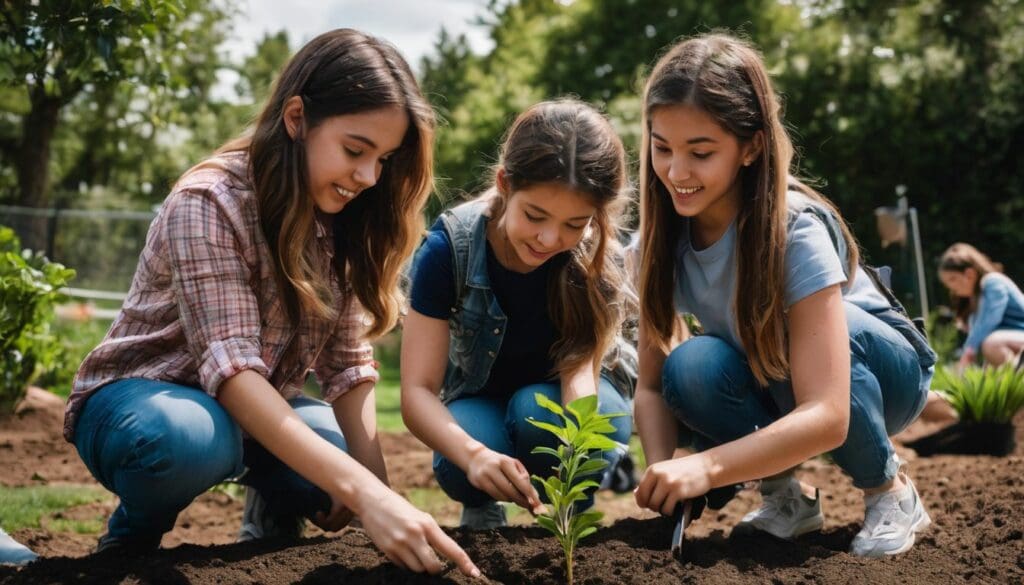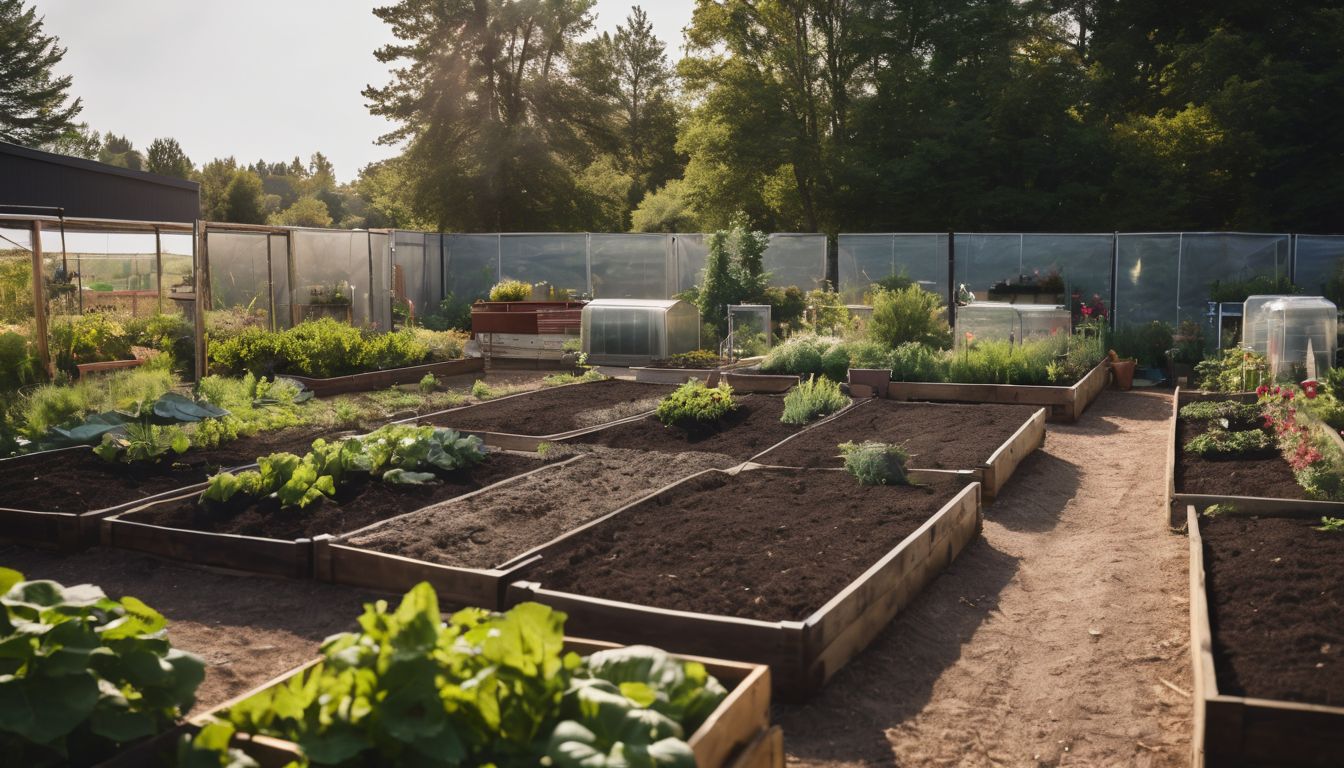Schools across the land are facing up to the urgent challenge of going green. We’re all in this together and, much like many of you, we’ve observed our own corridors could stand to be a tad more environmentally considerate.
Therefore, we’ve rolled up our sleeves and delved into research to unearth practical solutions. This blog post is your quintessential manual for steering schools towards a future rich in sustainability, brimming with actionable steps and collaborative community endeavours.
So let’s join hands and make a positive impact one step at a time!
Key Takeaways
- Schools encourage biodiversity by creating gardens and habitats, which attract pollinators and support local wildlife. These efforts engage pupils in conservation.
- Reducing canteen waste through composting, using reusable containers and sourcing package-free produce lessens environmental impact and promotes eco-friendly habits.
- Sustainable schools save energy and water with efficient lighting, low – flow taps, solar panels, and educating the community about resource conservation.
- Cutting down paper use involves digital communication for school assignments, double – sided printing policies, recycling drives, and educational programmes on responsible paper consumption.
- Collaborations with environmental organisations provide expertise for conserving resources on school grounds while promoting sustainability within the wider community.
Why Sustainability is Important for Schools
Sustainability in schools lays the foundation for eco-friendly practices that students can carry into their future. It teaches us to be environmental stewards, encouraging a lifelong commitment to conserving natural resources and reducing our environmental impact.
When we integrate sustainability initiatives into school curriculums, such as setting up recycling programs or installing gardens, we’re not just cultivating a greener campus – we’re sparking critical thinking about ecological consequences in young minds.
Our efforts help cut down on energy consumption and water use, which are vital steps towards sustainable development. Classrooms become living examples of how individual actions can contribute to broader climate action goals.
Reducing waste in canteens and promoting classroom composting take these lessons beyond theory, transforming them into tangible changes that benefit both the planet and school budgets.
As educators and learners adopt eco-conscious behaviors, they set positive precedents for families and communities, amplifying the impact of green initiatives across society.
Ways to Make Schools More Sustainable
Encouraging biodiversity through school gardens and wildlife habitats can promote a healthier ecosystem. Reducing waste in the canteen by implementing reusable containers and composting organic waste can significantly decrease the school’s environmental impact.
Encouraging Biodiversity
To encourage biodiversity on our school campus, we can create a butterfly garden by planting native flowering plants. These plants will attract pollinators and provide food for butterflies, bees, and other beneficial insects.
We can also establish bird feeders and nesting boxes to support local bird populations in our school’s green spaces. By creating these habitats, we can promote the presence of diverse plant and animal species while fostering an appreciation for nature among our students.
Furthermore, organising educational workshops and nature walks will help raise awareness about the importance of preserving local ecosystems and wildlife. These activities will engage students in conservation efforts and inspire them to take an active role in protecting biodiversity within their own community.
Reducing Waste in the Canteen
- Implement a composting system for food waste and biodegradable packaging to reduce the amount of organic material sent to landfill.
- Encourage the use of reusable containers and cutlery to minimise single-use plastic waste.
- Offer incentives for students and staff who bring their own reusable water bottles or coffee cups, reducing disposable drink container usage.
- Educate the school community on portion control to reduce food wastage at the canteen.
- Collaborate with local farmers or suppliers to source produce that eliminates excessive packaging, promoting a zero-waste approach.
Promoting Energy and Water Conservation
When it comes to creating a sustainable school, promoting energy and water conservation is crucial. By implementing the following initiatives, we can significantly reduce our environmental impact while teaching important lessons in conservation to our students:
- Installing energy – efficient lighting and appliances throughout the school to reduce electricity consumption.
- Implementing a “turn off the lights” campaign, encouraging students and staff to switch off lights when leaving empty rooms.
- Installing low – flow taps and toilets to minimise water usage.
- Introducing educational programmes that teach students about the importance of conserving energy and water resources.
- Setting up rainwater harvesting systems to collect water for irrigation and other non-potable uses.
- Incorporating solar panels on school rooftops or grounds to harness renewable energy sources.
- Conducting regular maintenance checks to ensure all fixtures and systems are operating efficiently, thus minimising energy and water wastage.
- Engaging students in eco – friendly competitions such as tracking their water and energy consumption and rewarding the most conscientious individuals or classes.
- Collaborating with local environmental organisations or businesses to host educational workshops on energy and water conservation practices for both students and staff.
- Providing resources for sustainable behaviour change, such as posters reminding everyone about turning off electronic devices when not in use or fixing leaking taps promptly.
Reducing Paper Waste
To reduce paper waste in our school, we implement digital communication methods for distributing information and assignments. We engage in double-sided printing to maximise the use of each sheet of paper.
Additionally, we encourage students and staff to reuse paper when appropriate and set up dedicated bins for recycling paper throughout the campus. By taking these actions, we actively contribute to minimising our environmental impact while also conserving resources and supporting sustainable practices.
As part of our sustainability initiatives, we promote electronic submission of assignments whenever possible to reduce the need for printed materials. This shift not only decreases paper consumption but also encourages students to embrace technology as a tool for learning and environmental conservation.
Encouraging Recycling and Creative Projects
To promote sustainability in schools, we can encourage recycling and creative projects through the following initiatives:
- Organise regular recycling drives for paper, plastic, glass, and metal to divert waste from landfill and conserve resources.
- Collaborate with local artists to conduct workshops using recycled materials, fostering creativity whilst promoting environmental awareness.
- Establish a ‘waste to art’ programme where students repurpose items that would have otherwise been discarded into artistic creations.
- Introduce a sustainable fashion show where students design and model clothing made from reused or upcycled materials.
- Set up a ‘reuse centre‘ on campus for students to exchange or repurpose items such as books, stationery, and clothing.
- Create a school-wide initiative to reduce single-use plastics by encouraging reusable alternatives such as water bottles and lunch containers.
Collaborating with the Community and Implementing Sustainable Practices
By partnering with environmental organisations, using eco-friendly cleaning products, implementing renewable energy sources, and encouraging walking and cycling to school, schools can collaborate with the community and implement sustainable practices.
These initiatives will not only reduce the school’s environmental impact but also promote a culture of sustainability within the local community.
Partnering with Environmental Organisations
To make our school project more sustainable, we collaborate with environmental organisations to gain valuable insights and knowledge about conservation efforts. By working together, we can implement effective strategies to reduce our environmental impact and create a greener campus.
This partnership allows us to tap into expert resources and access eco-friendly solutions that support biodiversity, energy conservation, waste reduction, and water consumption initiatives.
We aim to align with like-minded organisations dedicated to environmental education and sustainability initiatives. Through this collaboration, we contribute actively towards the community’s conservation projects while fostering a sense of responsibility among students for our planet’s well-being.
Using Eco-Friendly Cleaning Products
Schools can reduce their environmental impact by using eco-friendly cleaning products. These products help in conserving water and energy while ensuring a healthier indoor environment for students and staff.
Switching to eco-friendly cleaning products contributes to the overall sustainability initiatives of the school, aligning with conservation projects for students and campus sustainability efforts.
Introducing eco-friendly cleaning products supports waste reduction campaigns, promoting green school projects, and supporting environmentally conscious individuals. By incorporating these products into daily practices, schools actively participate in reducing their carbon footprint and encouraging student-led sustainability projects, fostering an eco-conscious school environment through simple yet impactful actions.
Implementing Renewable Energy Sources
To reduce our environmental impact, we can implement renewable energy sources in our schools. By investing in solar panels and wind turbines, we can generate clean electricity to power our classrooms and facilities.
This not only reduces our reliance on non-renewable energy sources but also sets an example for the community on sustainable practices.
Incorporating renewable energy sources aligns with our eco-friendly school practices and supports student-led sustainability projects. It demonstrates our commitment to green initiatives for schools and encourages a mindset of environmental conservation within the school community.
Encouraging Walking and Cycling to School
Encouraging walking and cycling to school benefits the environment by reducing carbon emissions, improves physical health, and helps to reduce traffic congestion around schools. Installing safe bike racks and creating designated walkways can encourage more students to leave their cars at home, reducing air pollution and promoting a healthier lifestyle for the whole community.
By providing incentives such as “walking buses” or “bike trains,” schools can create an enjoyable experience that encourages students to choose active transportation options over driving.
Involving local authorities in infrastructure improvements such as building more pedestrian-friendly paths and installing bike lanes can further enhance safety for those choosing to walk or cycle.
Conclusion
In conclusion, creating a sustainable school project is essential for our environment. We must take steps to reduce waste and conserve energy and water. Partnering with the community and implementing eco-friendly practices can make a significant impact.
Let’s work together to build a greener future for our schools and communities.
FAQs
1. What does setting up a sustainable school project involve?
Setting up a sustainable school project involves introducing eco-friendly practices to reduce environmental impact, such as biodiversity conservation and water consumption reduction.
2. Can students lead sustainability projects at school?
Yes, student-led sustainability projects are great for involving young people in developing ecoconscious initiatives that promote sustainability within the school environment.
3. How can we make our schools more eco-friendly?
Schools can become more eco-friendly by adopting earthfriendly programs like installing a school garden and integrating sustainable classroom activities into the curriculum.
4. What are some examples of sustainable classroom activities?
Examples include starting recycling campaigns, creating arts from recycled materials or engaging in lessons about conserving resources as part of an overall green school program.
5. Why is it important to have an eco-consciousness in schools?
Fostering an eco-consciousness in schools equips students with knowledge and values critical for reducing their carbon footprint and contributing positively towards Earth’s future.





